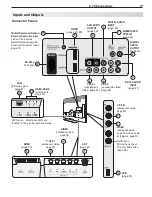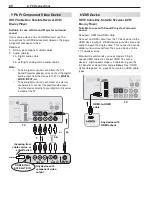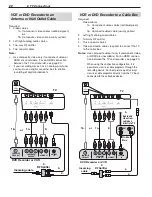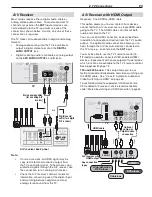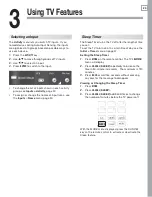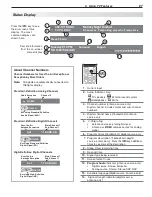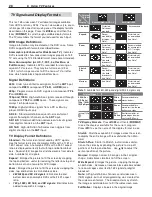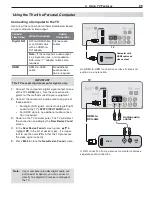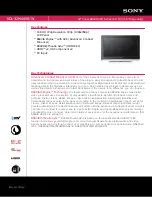
18
2. TV Connections
Inputs and Outputs, continued
1. ANT (Antenna)
Connect your main antenna or direct cable service (no
cable box) to
ANT
. The
ANT
input can receive digital
and analog over-the-air channels from a VHF/UHF
antenna or non-scrambled digital/analog cable source.
2. HDMI™ Inputs (High-Definition
Multimedia Interface)
The HDMI inputs support uncompressed standard and
high-definition digital video formats, PCM digital stereo
audio, and digital 5.1 surround sound. These inputs
are HDCP (High-Bandwidth Digital Copy Protection)
compliant.
Mitsubishi recommends you use category 2 HDMI
cables,
also called high-speed HDMI cables, to
connect HDMI 1.3 source devices. High-speed cat-
egory 2 cables bring you the full benefits of Deep Color
and
x.v.Color
.
The TV’s HDMI inputs are compatible with many DVI-D
and HDMI computer video signals.
Use the HDMI inputs to connect to CEA-861 HDMI
compliant devices such as a high-definition receiver
or DVD player. These inputs support 480i, 480p, 720p,
1080i, and 1080p video formats.
These HDMI inputs can also accept digital DVI video
signals. To connect a device’s DVI output to the TV’s
HDMI input, use an HDMI-to-DVI adapter or cable plus
analog audio cables. Connect the analog audio cables
to the
DVI/PC INPUT AUDIO
jacks on the TV to receive
left and right stereo audio from your DVI device.
3. Y Pb Pr (Component Video)
Connect devices with component video outputs to this
jack. Use the adjacent
AUDIO R
and
L
jacks if you wish
to send audio to the TV.
4. VIDEO (Composite Video)
Connect a VCR, DVD player, standard satellite receiver,
or other A/V device to the TV. Use the adjacent
AUDIO
R
and
L
inputs if you wish to send audio to the TV.
5. AVR AUDIO OUTPUT
Use
AVR AUDIO OUTPUT
to send analog audio of the
current program to an analog A/V surround sound
receiver or stereo system. Digital audio from digital
channels and HDMI devices is converted to analog
audio by the TV for output on this jack. This is the only
audio connection needed to the TV if using an analog
A/V receiver or stereo system.
Headphones.
These jacks can also be used for head-
phones that accept standard line level audio signals.
An adapter may be needed.
6. DIGITAL AUDIO INPUT
This input sends digital surround sound to the TV’s
speaker array from a device, such as a DVD player,
connected to
INPUT 2
.
7. SUBWOOFER OUTPUT
Connect a powered subwoofer to complement Sound
Projector speaker effects.
8. DIGITAL AUDIO OUTPUT
This output sends Dolby Digital or PCM digital audio
to your digital A/V surround sound receiver. Incom-
ing analog audio is converted by the TV to PCM digital
audio. If you have a digital A/V receiver, in most cases
this is the only audio connection needed between the
TV and your A/V receiver.
9. DVI/PC AUDIO INPUT
When connecting a DVI device to one of the TV’s HDMI
inputs, use these jacks to send left and right analog
audio to the TV.
HDMI Cable Categories
HDMI cables are available as Category 1 and Category 2
types.
Category 2 Cables
•
(also called high-speed HDMI
cables). Newer, HDMI 1.3-compliant DVD players,
video games, and set-top boxes require Category 2
cables, suitable for clock frequencies up to 340 MHz
or data rates of up to 10.2 gigabits per second. Use
category 2 cables for high-speed 1080p HD signals
carrying extended color encodings (i.e., 30 or more
bits, also called Deep Color). Category 2 cables are
also suitable for standard HDTV signals.
Category 1 Cables
•
(also called standard HDMI
cables). Category 1 cables may be unmarked. They
are suitable for standard HDTV 720p, 1080i, and
1080p signals with 8-bit color depth. Use category 1
cables for clock frequencies up to 74.25 MHz or data
rates of up to 2.23 gigabits per second.














